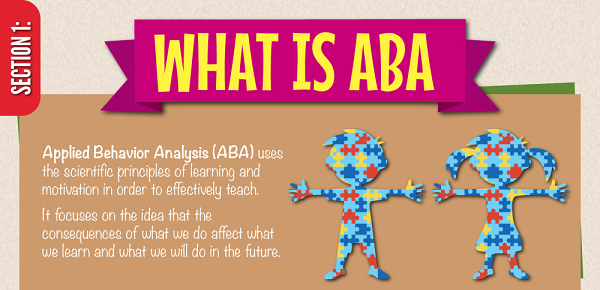Applied behavioral analysis (ABA)
ABA therapy, or applied behavioral analysis, is often regarded as the most effective, comprehensive, and evidence-based treatment for children and adults on the autism spectrum. In fact, over 40 years of research supports using ABA therapy techniques with individuals on the autism spectrum, as well as those with an intellectual or behavioral disorder. ABA utilizes specific principles that guide intervention and seeks to decrease the occurrence of disruptive behaviors, aggression, obsessive compulsive behaviors, and other challenges.
ABA encompasses numerous treatment modalities, which are precisely designed by a Board Certified Behavior Analyst (BCBA) to meet the unique needs of each client. ABA assessments are performed to identify the appropriate methods to use, as well as positive behavioral approaches and support. State-of-the-art software allows clinicians to quickly adapt and change targeted interventions to maximize the client’s time in the program. Progress is charted and monitored on a regular basis.
Comprehensive ABA treatment programs produce positive changes in the client’s daily functioning; IQ score; adaptive skills; social functioning; communication; interaction; and language development. These shifts help the individual and family to adapt, move forward, and continue growing.
ABA infographic kindly provided by North Shore Pediatric Therapy.
Behavioral health intervention planning
A behavior intervention plan (BIP) is a unique, comprehensive plan based upon the information gathered from a functional behavioral assessment (FBA) and/or functional analysis (FA) to address difficult and challenging behaviors. In order for a plan to be effective, it must be developed based upon an FBA or FA and include the information below. Without this information, an intervention plan will be ineffective and can result in more harm than good.
A behavior intervention plan should include the following:
A clear definition of the problem behavior to be reduced, in measurable and observable terms
A list of behaviors to increase or decrease, with the plan
New behaviors to teach, which will replace the old, more challenging behavior
A detailed plan on teaching the new behaviors
Preventative/antecedent-based interventions
Interventions that prevent challenging behaviors from occurring while new, more acceptable behaviors are taught
Reinforcement/consequence-based Interventions
Specific strategies that increase the possibility of the new, more appropriate behavior to occur
A method on the data to be collected, which will determine if the intervention is working
A training plan to implement interventions
FA/FBA definition
Functional behavioral assessments (FBA)
An assessment used to determine factors that cause and maintain problem behavior. Based upon the data gathered from the FBA, unique and specific interventions are designed to address problem behaviors.
Functional analysis (FA)
A functional analysis (FA) is a type of FBA, which is more precise in identifying and addressing problem behaviors.
An FA is used to identify different variables that influence behaviors by identifying the context in which they occur, as well as the antecedents and consequences that maintain such behaviors. Interventions based upon an FA are much more effective at managing challenging behaviors.
What to expect...
Where and how will services be provided?
In-person and across multiple settings such as the home, school, community and office
Via secure, encrypted Skype connection for families living in rural areas
Your team:
Parent/caregiver
Extended family, if needed or requested
Board Certified Behavior Analyst (BCBA) from our agency
Registered Behavior Technician/Behavior Technician (RBT/BT) to provide the direct service
Other professionals:
School
Daycare
Physician
Speech and language pathologist
Anyone you feel is important to the therapeutic process
First 30-60 days:
First 30 days or less:
Insurance authorization
Initial assessment and intervention planning
After 30 days:
Meet with the specific staff that will be providing autism therapy services
As a team, we will work together to identify the most socially significant behaviors to address in treatment
Schedule services to be provided in the home, school, office or community setting(s):
Amount of services provided range from about 5-20 hours per week, based upon the initial assessment and insurance authorization
First 2 weeks of services:
Initially it will look like staff is just playing/interacting with the client and not addressing any therapeutic interventions:
The purpose of the first couple weeks of services is to ensure the client views the RBT as a positive and fun person in their life
The goal is to ensure the client and staff have a positive therapeutic foundation prior to beginning the hard and difficult work ahead
What will services look like?
Working together as a team:
The BCBA works with everyone to develop the specifics of the intervention plan
2-3 target goals/skills will be identified for implementation:
Not all goals will be implemented at the same time, but will be added as the client makes progress in treatment
As the client masters skills, new skills will be taught
The BCBA will train staff and team members on how to implement the interventions
The BCBA will directly observe and provide support to team members implementing the plan, a specific percentage of the time, to ensure high quality services across settings
The Team will talk monthly to review and adjust the current plan as needed:
Data about the intervention will be gathered and reviewed often to help direct services
The family has access to the interventions and data through our electronic health records program, to monitor the client’s program
Interventions include:
Fun, interactive, and effective ways to engage your child in the process of learning new skills and how to “generalize” or implement these skills across multiple settings
Oftentimes the client’s interests are used to help him/her engage in interventions
Use of natural life events to teach and coach skills. Natural Environment Teaching (NET):
For example, when teaching a child how to take turns with peers, intervention may occur on the playground or in school
For example, when teaching a child how to sit at the table for longer periods of time, to stay engaged in a task, staff may use dinnertime or a board game to teach these skills


